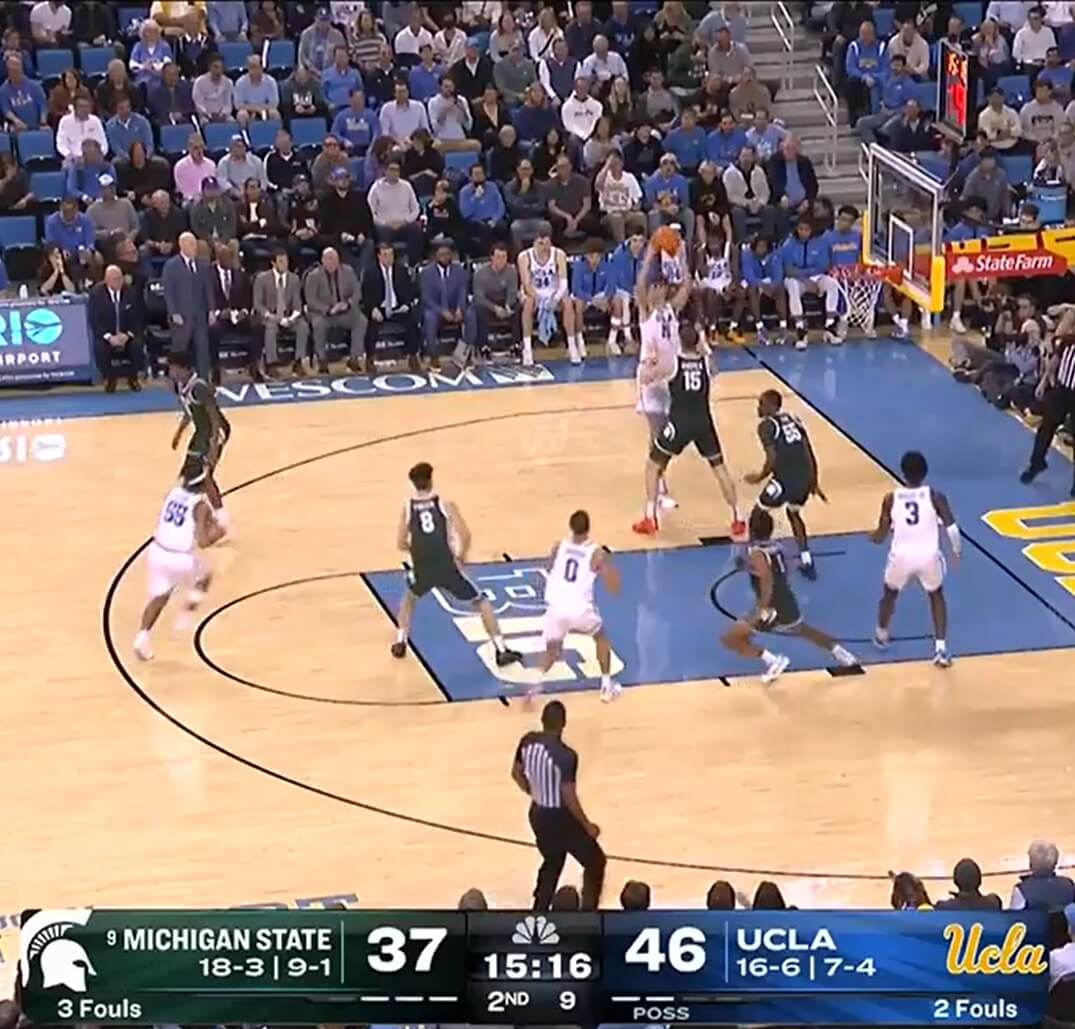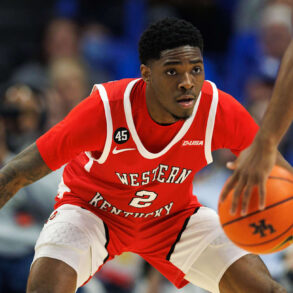College basketball players have until Tuesday to enter the transfer portal, and there undoubtedly will be more entrants leading up to that deadline.
But by and large? The hay’s already in the barn.
With the portal having been open a month, it shouldn’t be surprising that most of the best available players are already accounted for. Fifteen of The Athletic’s top 20 transfers have found new homes. Texas Tech wing Darrion Williams, Florida State wing Jamir Watkins, St. John’s wing RJ Luis, Washington State wing Cedric Coward and North Carolina guard Ian Jackson are the five still available — and only 11 of our top 50 remain free agents.
Advertisement
So enough dust has settled to start homing in on some of this cycle’s most important moves.
Behold, five of my favorite transfer portal fits (in alphabetical order). Emphasis on fit, because these are not the five most-talented players who changed teams. Rather, these are five situations I think will be most beneficial both for the player and his new team. Only one player picked is in the top 10, per CJ Moore and Sam Vecenie’s rankings — but that doesn’t mean all five won’t pay major dividends next season.
Silas Demary Jr., UConn
2024-25 stats (at Georgia): 13.5 points, 3.9 rebounds, 3.1 assists and 1.7 steals per game, while shooting 37.4 percent from 3 and 80.4 percent from the free-throw line.
The Athletic transfer portal rank: No. 11
UConn’s biggest shortcoming this season, without question, was its season-long defensive issues. But not far behind was the Huskies’ inconsistency at point guard, where career reserve Hassan Diarra and Saint Mary’s transfer Aidan Mahaney struggled to fill the void left by Final Four Most Outstanding Player Tristen Newton. Diarra posted solid counting statistics — 5.7 assists per game, with a top-25 assist rate nationally, per KenPom — but had limited scoring ability. Meanwhile, Mahaney’s transition from shooting guard to lead playmaker never fully panned out. (Diarra has since graduated, and Mahaney re-entered the portal.)
Enter Demary, who is cut from the same do-everything cloth as Newton and should help Dan Hurley’s offense get back to its pristine 2023 and 2024 form.
Demary’s emergence over Georgia’s final 10 games, including a home win over eventual national champion Florida, was critical to the Bulldogs making their first NCAA Tournament in a decade. The 6-foot-5 guard averaged 19.3 points, 3.6 rebounds and 3.5 assists per game over that stretch. Per Synergy, 53.5 percent of Demary’s offensive production came as a pick-and-roll ballhandler or a spot-up shooter. And wouldn’t you know? Those are easily the two most prevalent actions in UConn’s offense, accounting for about a third of the Huskies’ total possessions. The way Demary manipulates ball screens — especially if his defender goes under in drop coverage or lazily chases over — is going to be a nightmare to defend within Hurley’s system:
Even solid defenders, such as Florida’s Alijah Martin and Alex Condon, can only do so much. Good offense almost always beats good defense:
Demary shot 40.9 percent from 3 as a pick-and-roll handler this season, per Synergy. He’s also prolific at drawing free throws while driving from those situations; his five personal fouls drawn per game ranked in the 99th percentile nationally, per CBB Analytics. And while Demary is definitely more of a score-first lead guard — especially in the role he filled at Georgia — the rising junior did have 14 games this season with four or more assists, eight of which came in February and March. All of which is to say nothing of Demary’s defense and how he utilizes his length — which is much more to Hurley’s liking — to force turnovers.
Advertisement
With Demary, fellow transfer Malachi Smith (Dayton), returning sharpshooter Solo Ball and two incoming top-25 recruits, the Huskies are once again poised to have one of the sport’s best backcourts.
Aday Mara, Michigan
2024-25 stats (at UCLA): 6.4 points, 4 rebounds, 1.6 blocks and 1 assist per game.
The Athletic transfer portal rank: No. 38
If anyone is going to fully unlock the 7-foot-3 Mara’s passing skills, it’ll be Dusty May.
The coach’s first season at Michigan — in which the Wolverines won the Big Ten tournament — was defined by his creativity using dual 7-footers Danny Wolf and Vlad Goldin, especially in supersized pick-and-rolls with Wolf as the primary handler. That combo was so effective that it vaulted Wolf into first-round territory and affirmed Goldin’s stock as a likely second-rounder.
If Michigan’s early work in the transfer portal is any indication, May once again plans to play through his frontcourt. In addition to Mara, Michigan has signed forwards Yaxel Lendeborg (UAB) and Morez Johnson (Illinois), both ranked as top-six transfers by The Athletic. Those two figure to start next season, but Mara will be a key piece of the puzzle, regardless. And if May can think outside the box on how to best use the rising Spanish junior, the juice should be worth the squeeze; there’s a reason Mara arrived in college as a five-star recruit with first-round buzz, before two underwhelming seasons at UCLA.
Over UCLA’s last 17 games, when Mara became more of a fixture, he averaged 8.6 points, 4.9 rebounds, 2.3 blocks and 1.4 assists per game in just 17.1 minutes. His bread and butter offensively was as a low-post scorer — 44.4 percent of Mara’s shots came at the rim, per CBB Analytics, where he shot 67.2 percent — who could also convert on offensive putbacks. Mara being in the 99th percentile in offensive rebounding rate, per CBB Analytics, naturally led to plenty of those opportunities. May will surely use Mara as an interior scorer — but what’s much more intriguing is how he utilizes the Spaniard’s passing, which might be his best and most slept-on attribute. I’d love to see Mara as a high-post playmaker. High-pointing the ball like he does here — in the air, without ever setting his feet — and re-directing it on a perfect bounce pass in stride is special stuff:
His height also gives Mara a different vantage point than nearly anyone else in the sport. The only reason he’s able to make the following pass against Michigan State is because he sees over the top of the defense:
Look at where Michigan State’s defenders are when Mara gets ready to pass. Four guys are in the paint — yet Mara finds, and delivers, on the one clear lane available:

Mara’s also a tremendous shot blocker, whose block rate was in the 100th percentile nationally, per CBB Analytics. If May can unlock even more out of Mara? He might unlock a national title contender.
KeShawn Murphy, Auburn
2024-25 stats (at Mississippi State): 11.7 points, 7.4 rebounds, 1.6 assists and 1.1 blocks per game.
The Athletic transfer portal rank: No. 78
Advertisement
Most of Auburn’s Final Four roster, including All-American center Johni Broome, is gone, meaning it’s time for Bruce Pearl to restock. That’s where Murphy comes in, as a plug-and-play frontcourt piece with proven success in the SEC. He was Mississippi State’s leading rebounder and second-leading scorer this season.
A borderline top-150 recruit coming out of high school, Murphy finally broke out last season as one of the best sixth men in the country. Despite coming off the bench, he took the second-most shots and played the third-most minutes of anyone on Chris Jans’ roster. Murphy pencils in as a starter for the Tigers, but Pearl — whose preference historically has been to go nine- or 10-deep — must love the idea of adding someone so productive who’s already used to playing under 30 minutes a night.
At 6 feet 10 and 230 pounds, Murphy is almost exclusively an interior player offensively, but he’s a smart cutter who should excel in Pearl’s Flex offense. But where Murphy really thrives is as a pick-and-roll roller, and the pairing with Tahaad Pettiford on ball screens will be scary. Murphy averaged 1.368 points per possession (PPP) as a roller this season, per Synergy, which rates as “excellent” and in the 90th percentile nationally. To that point, Murphy scored on over two-thirds of all his roll attempts, while drawing fouls on 10.3 percent on them. Hit him with the right pocket pass, which Pettiford will, and odds are you’re getting a bucket.
The reasons Murphy is so effective in those settings? Because of his touch — both at the rim and on his patented “push”-like runner — and how he glides through a defense, like so:
If Murphy continues the ascent he showed this season, there’s no reason he can’t be the top interior option for an Auburn team that should contend in the SEC.
Henri Veesaar, North Carolina
2024-25 stats (at Arizona): 9.4 points, 5 rebounds, 1.3 assists and 1.1 blocks per game.
The Athletic transfer portal rank: No. 5
UNC was one of the shortest high-major teams this season, and Hubert Davis clearly was not going to tolerate another undermanned frontcourt. The best way to remedy that? Adding arguably the best center in the portal, Veesaar, who is the Tar Heels’ first 7-footer since Tyler Zeller in 2012.
Advertisement
Veesaar was originally slated to be part of Arizona’s massive three-man center rotation alongside Tobe Awaka and Motiejus Krivas, but when Krivas suffered a season-ending foot injury, it shifted Veesaar into a more prominent role — and he quickly proved that he could more than handle it. Per CBB Analytics, the Estonian had Arizona’s best on-off rating by a mile, with the Wildcats being a staggering 17.6 points per 100 possessions better with Veesaar on the floor than off it. That’s because, per KenPom, Veesaar was top-50 nationally in 2-point percentage, as well as top-100 nationally in offensive rebounding percentage and offensive rating. And it’s worth emphasizing again: Veesaar was a beast on the offensive glass, scoring 1.563 PPP on offensive putbacks, per Synergy, which rated as “excellent” and in the 96th percentile nationally. Veesaar was fourth in Division I last season in PPP on putbacks among players with at least 40 such possessions — one spot ahead of Maryland big and likely lottery pick Derik Queen. Watch this example against Baylor. Veesaar is outside the 3-point arc when his teammate takes the initial shot, yet he still corrals the offensive board:
All of this should excite UNC fans. As should adding transfer forward Jarin Stevenson (Alabama) and top-10 high school recruit Caleb Wilson to further fortify the frontcourt. But what Davis might be most thrilled with is what Veesaar offers defensively. He’s the legitimate rim protector UNC lacked last season, and his mobility for his size is impressive, especially how he covers ground in drop coverage (which has historically been Davis’ preferred ball-screen defense). Arizona frequently played Veesaar at the level of the screener, which led to him getting burned on a few pick-and-pops, but he mostly held up in that role — including this sequence against Texas Tech star JT Toppin. Not many people can stay with Toppin or contest his multiple efforts:
Adrian Wooley, Louisville
2024-25 stats (at Kennesaw State): 18.8 points, 5.2 rebounds, 3.6 assists and 1.4 steals per game while shooting 42.2 percent from 3 and 76.9 percent from the free-throw line.
The Athletic transfer portal rank: No. 23
I’m no math expert, but it doesn’t take a genius to pick up patterns this obvious.
This season, during Pat Kelsey’s inaugural campaign at Louisville, the Cards took 74.7 percent of their shots either at the rim or from 3. And in his freshman season with the Owls, in which the 6-foot-5 Wooley won Conference USA Rookie of the Year, the Alabama native took 76.6 percent of his shots either at the rim or from 3.
That’s more than a Venn diagram; that’s two overlapping circles.
Louisville has added a bevy of high-profile guards this offseason — Ryan Conwell (Xavier) and Isaac McKneely (Virginia) from the transfer portal, plus top-10 high school recruit Mikel Brown Jr. — but Wooley’s game is as tailor-made for Kelsey’s system as any of them. Louisville was third among all high-major teams in 3-point attempt rate this season, per KenPom, with a staggering 47.8 percent of its shots coming from deep. Wooley’s ability to shoot on or off the ball should blend perfectly with that offensive philosophy.
Advertisement
Per Synergy, Wooley was in the 75th percentile or better nationally in all four of his most-frequent offensive actions, but he was “excellent” as both a pick-and-roll handler and a spot-up shooter. The latter is sort of obvious: Wooley was one of 55 players across all of Division I this season who attempted at least five 3s per game and made 41 percent or more of them. (Some notable others? Conwell and McKneely. Kelsey has a type.) But given the number of shooters around him, I’m almost more fascinated in how Wooley’s pick-and-roll game will translate. The tape is encouraging, even considering he could afford to pack more muscle onto his 180-pound frame. Wooley scored half of his 28 points against Liberty in the CUSA tournament off pick-and-rolls, per Synergy, and the tape is littered with impressive finishes:
Here Wooley is driving on future top-3 pick Dylan Harper — and while he doesn’t get all the way to hoop, especially since Harper has 35 pounds on him, he still converts in what was Kennesaw State’s only win over a high-major team all season.
How all those guards shake out in Louisville’s rotation remains TBD, but Wooley’s fit as someone who can do it all — perhaps to a greater extent than any of Conwell, McKneely or Brown — means he’ll have a prominent role on a team that will begin next season ranked in the top 10.
(Top photo of Georgia’s Silas Demary Jr. and Gonzaga’s Khalif Battle and Ben Gregg: Jamie Squire / Getty Images)
This post was originally published on this site be sure to check out more of their content.







